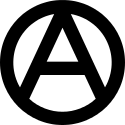Anarchism in Turkey
Anarchism in Turkey only began to emerge in 1986 when the monthly magazine Kara began publication. Before this magazine there was no visible anarchist movement on the Turkish political scene.
Marxism was an influential ideology in Turkey's revolutionary movements. In the 1980s, Marxism disintegrated in Turkey due to the military coup headed by Kenan Evren. Nearly all Marxist movements were crushed by the military government. In this situation, many Marxist militants were faced with a dilemma—the tension between the ultimate aim of Marxism (a stateless and classless society) and the reality of Marxist regimes historically (with heavily bureaucratised state apparatuses and the repression of all oppositional politics). This dilemma led many Marxists to reject the statist politics of Marxism, and they sought ways to reach the classless society without retaining a state during the transition. As a result of this, many embraced anarchism.
The main organisations of this anarchist communist tendency is the platformist Anarşist Komünist Inisiyatif (AKI, or Anarchist Communist Initiative). Another organisation of this tendency is the Devrimci Anarşist Faaliyet (DAF, or Revolutionary Anarchist Action), active since 2008.[1] Also there is local organisations as labelled Anarchy Initiative. Istanbul Anarchy Initiative, Ankara Anarchy Initiative, Eskisehir Anarchy Initiative are active organisations since 2013–14. Anarchy Initiatives are most effective organisations in Turkey and they have a completely different theory than other anarchist organisations.
On the other hand, during the military rule, much of the left wing intelligentsia questioned Marxist collectivism and the Leninist understanding of organisation. This led them to the idea that there is a contradiction between society and the individual. There is a small individualist tendency as a result. Part of this tendency embraces the idea of the "responsible individual".
